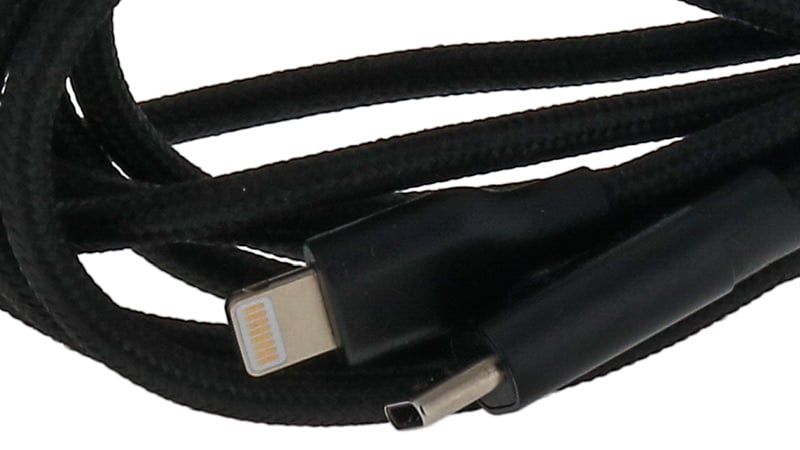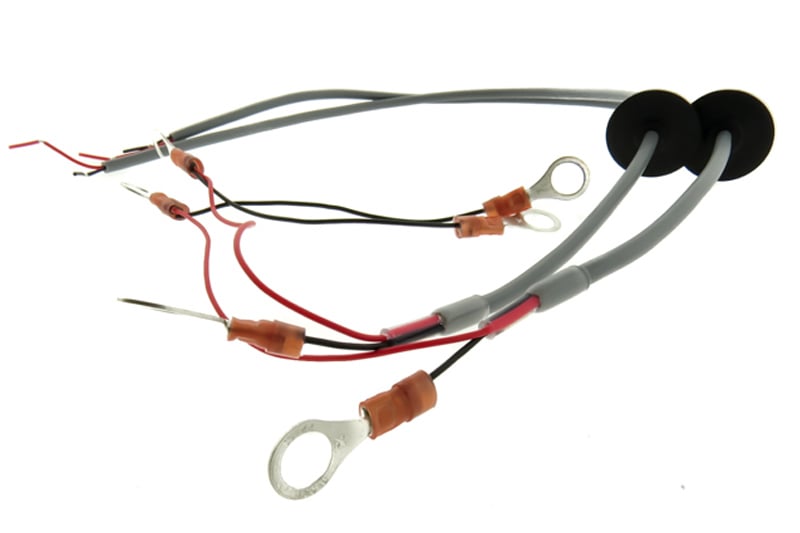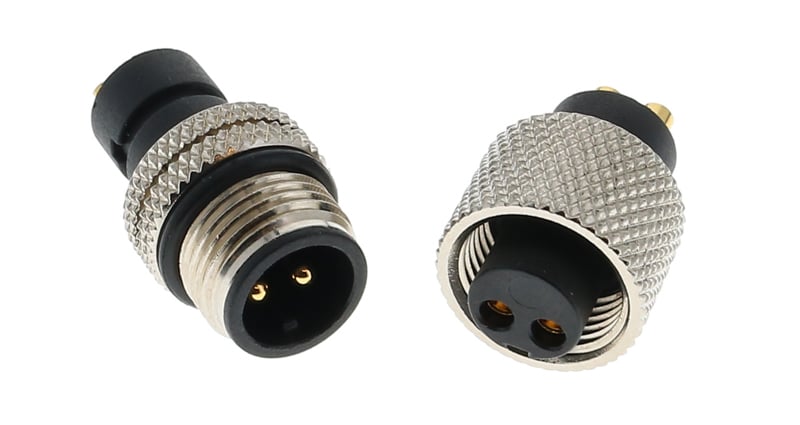Getting your product to market fast and staying within budget is the obvious goal for all new development projects. Many of these projects require some sort of assembled circuit board, battery, or touchscreen, and therefore they all will need some type of custom electrical cable or wire harness.
Choosing a readily available wire harness is especially important early in projects where designs change rapidly and three or four revisions may be necessary to launch production. Cable assembly types such as D-sub, USB-C, and circular connectors offer high performance at low cost. Spade terminals, ring terminals, and IDC cables paired with ribbon cables are simpler options for higher voltages and power circuits. Collectively, the odds are that these five cable types can help solve most of your cable needs for any new design project.
D-Subminiature Connector Cable
A D-subminiature connector is a type of electrical connector commonly used in computer and telecommunications applications. It was originally designed as a smaller, more compact alternative to the larger D-type connector and has since become a standard for many electronic devices. D-sub connectors come in a variety of sizes and pin configurations, making them versatile and adaptable to many different applications. They are important because they provide a reliable and secure means of connecting electronic components, while also being compact and easy to use.
Thumbscrews are used in tandem with many d-sub connectors to securely fasten two components together. It is designed to ensure that the components remain securely connected, even under harsh conditions such as vibrations or shock. The thumbscrew is typically made of metal and has a knurled surface to make it easy to grip and turn by hand. The threaded shaft of the thumbscrew is inserted through a hole in one component and then screwed into a threaded hole on the other component, thereby securing the two components together.

Example of D-sub cable with thumbscrews.
D-sub cables are a low-cost solution for high-density connectors because they are relatively easy to manufacture and are widely available in a range of pin counts and configurations. The cables are typically made with a shielded wire to prevent electrical interference and ensure reliable signal transmission.
One of the key advantages of using D-sub cables is their low cost compared to other high-density connector solutions. They are relatively easy to manufacture and are widely available. Using D-sub cables with thumbscrew locking mechanisms can be a low-cost solution with zero NRE (non-recurring engineering) cost if you already have the necessary tools available in your home or workplace.
D-sub cables and connectors are available in a variety of pin counts and arrangements; the most common configurations are the 9-pin, 15-pin, 25-pin, and 37-pin configurations. However, D-sub connectors are also available in higher-density configurations, such as the 50-pin, 68-pin, and 78-pin configurations. These higher-density connectors are used in more complex electronic systems where a large number of pins are required.
USB-C Connector
USB-C connector is a type of connector that has become increasingly popular in recent years due to its versatility and compatibility with a wide range of devices. First introduced in 2014, they are designed to be smaller, more compact, and more reversible than traditional USB connectors.
One of the main advantages of USB-C connectors is their ability to transfer data at high speeds, with some cables supporting data transfer rates of up to 10 Gbps. This makes them ideal for transferring large files, such as high-resolution videos and images, quickly and efficiently.

Example of USB-C connector cable.
In addition to data transfer, they are also capable of delivering power to devices. This means that they can be used to charge smartphones, tablets, laptops, and other electronic devices, which has made them a popular choice for consumers looking for a single cable that can do it all.
Another key advantage is their ability to support a range of protocols and standards, including HDMI, DisplayPort, and Thunderbolt. This means that a single USB-C cable can be used to connect a laptop to an external monitor, transfer data to an external hard drive, and charge a smartphone all at the same time.
There are several benefits of using a USB-C connector, including:
- Versatility: A single USB-C cable can be used to charge a smartphone, transfer data to an external hard drive, and connect a laptop to an external monitor.
- High-speed data transfer: Some cables support data transfer rates of up to 10 Gbps. This makes them ideal for transferring large files quickly and efficiently.
- Reversible design: They can be plugged in upside down or right-side up. This makes them easier to use and more convenient for consumers.
- Power delivery: They can be used to charge smartphones, tablets, laptops, and other electronic devices. This has made them a popular choice for consumers looking for a single cable that can do it all.
- Compatibility with multiple protocols: USB-C connectors are designed to be compatible with multiple protocols and standards, including HDMI, DisplayPort, and Thunderbolt. A single USB-C cable can be used to connect a laptop to an external monitor, transfer data to an external hard drive, and charge a smartphone all at the same time.
Spade and Ring Terminal Wire Harnesses
Spade and ring terminal harnesses are a type of electrical harness that is commonly used in a variety of industrial and automotive applications. The spade terminals are flat and have a small hole in the center, while the ring terminals are circular and have a hole in the center that can be crimped onto a stud or bolt.

Example of ring terminal wire harness.
One of the main advantages is their versatility. They can be used to connect a wide range of electrical components, including switches, relays, and motors, to power sources and other electrical components. Additionally, they are easy to install and can be quickly and easily connected to the desired components using standard crimping tools. They are also durable and can withstand harsh environments, making them ideal for use in industrial and automotive applications.
Another advantage of spade and ring terminal harnesses is their ability to simplify wiring and reduce installation time. By using pre-terminated harnesses, installers can save time and reduce the risk of wiring errors, which can help to improve overall system reliability and reduce costs.
Benefits of using spade and ring terminal wire harnesses:
- Ease of installation: Spade and ring terminal harnesses are easy to install, even for those with little experience in wiring or electrical work. The terminals can be quickly and easily connected to the desired components using standard crimping tools or by hand.
- Time-savings: Because spade and ring terminal harnesses are pre-terminated, they can save installers significant time and reduce the risk of wiring errors. This can help to improve overall system reliability and reduce costs associated with installation and maintenance.
- Versatility: Spade and ring terminal harnesses are made with readily available components and are able to be used with a wide range of AWG wire sizes. These are rarely the cause of major schedule delays because they are almost always available.
IDC Ribbon Cables
IDC (Insulation Displacement Connector) with ribbon cable is a type of electrical connector that is commonly box builds, computers, and consumer electronics. An IDC with ribbon cable consists of a flat multiconductor cable that has an IDC connector that is designed to pierce through the insulation and contact the conductors. The connector has a series of sharp blades that pierce through the insulation and create an electrical connection between each pin and wire.

Example of IDC ribbon cables.
One of the main advantages of IDC ribbon cables is their ease of use and low cost. The IDC connector can be quickly and easily attached to the ribbon cable using standard crimping tools, without the need for stripping or soldering. This makes it a popular choice for mass-produced electronic products.
Another advantage is their high density. Because the conductors are arranged in a flat ribbon, they can accommodate a large number of conductors in a small space.
IDC with ribbon cable is an important component in many electronic systems. As an engineer, it is important to understand their design and application to ensure that they are properly integrated into electronic systems and provide reliable performance over the long term.
Waterproof Circular Connector Cable
Waterproof circular connector cables are designed to provide reliable and secure connections in harsh environments where water, dust, and other contaminants may pose a risk to the performance of electrical systems. These connectors are commonly used in applications such as aerospace, marine, military, and industrial systems where ruggedness and durability are essential.
Waterproof circular connector cables come in a variety of sizes and configurations to accommodate different wire gauges and types, and they are typically made of high-quality materials such as stainless steel, aluminum, and plastic that are resistant to corrosion and abrasion.

Example of waterproof circular connectors.
One of the key features of waterproof circular connector cables is their ability to maintain a watertight seal even when subjected to high-pressure water and other contaminants. This is achieved through the use of advanced sealing technologies such as O-rings, gaskets, and silicone seals that prevent water and other contaminants from entering the connector and causing damage to the electrical system.
These cables also offer easy installation and maintenance and are typically designed with a simple plug-and-play interface that makes it easy to connect and disconnect them from the electrical system. This is particularly important in applications where frequent maintenance and repair are required.
Summary
With all the cable and connector options out there, it can feel overwhelming to choose the best option. Since all a cable is doing is passing power or data, the truth is that there are many options that will work for the job. Starting out with a low-cost and highly reliable connector type can help quickly flush out designs and accelerate timelines. If you plan on making several design iterations with inexpensive parts, use one of these five cable assembly types to save your project time and money.
Key Takeaways
- Readily available cable assemblies accelerate prototyping: Early-stage projects benefit from standard, low-cost cable options that support multiple design revisions without delays.
- D-sub connectors balance cost and reliability: With versatile pin configurations and secure thumbscrew fasteners, D-sub cables provide high-density connections at minimal expense.
- USB-C offers unmatched versatility: Supporting high-speed data transfer, power delivery, and multiple protocols like HDMI and Thunderbolt, USB-C simplifies connectivity across devices.
- Spade, ring, and IDC ribbon cables simplify wiring: These options reduce installation time, improve reliability, and are readily available for power, signal, and compact applications.
- Waterproof circular connectors ensure rugged performance: Designed for harsh environments, their seals prevent contamination and maintain durability in aerospace, marine, and industrial applications.
















